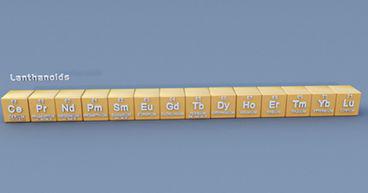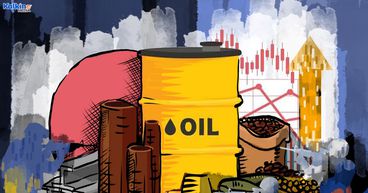Graphite
About
| Index | Price | Change |
|---|
Dark grey or black in colour, graphite is a naturally occurring crystalline form of carbon. Graphite is soft with very low specific gravity material. It could easily cleave under light pressure but can withstand extremely high temperatures. The material is nearly inert in nature, making it appropriate for metallurgy and other industrial applications.
Graphite is used in the manufacturing of pencils, lubricants, batteries, foundry facings, shoe polishes, arc lamps and even cores of nuclear reactors. Graphite makes the nuclear reaction sustainable for producing energy in a controlled fashion. A brick wall-type structure is created with graphite, which helps to reduce the speed of neutrons to complete the reaction.
Interestingly, graphite and diamond are pure forms of carbon. Diamond is the hardest naturally occurring substance, while graphite is brittle and soft. Graphite is dark and opaque, while diamond could be colourless and transparent. Such contrast in physical properties of the two pure forms of carbon originates due to differences in the process of their formation.
Graphite is formed within the earth’s crust under the low pressure and temperature zone, while diamond is formed in the mantle at extremely high pressure and temperature. Graphite crystallises in the hexagonal structure while diamond has an octahedral or tetrahedral structure.
Synthetic graphite
This type of graphite is prepared by heating petroleum coke, coal tar or other high carbon materials at a temperature range of 2500 to 3000 degrees Celsius. Synthetic graphite is chemically the same as natural graphite, but has a higher purity of more than 99% carbon, and is used in specialised industries, including battery electrode manufacturing, furnaces, and nuclear reactors.
Demand and Supply
China dominates the global graphite market with over 79% of the total production in 2021. China rules every aspect of the graphite supply chain, from mining to downstream processing. It is also the world’s largest consumer of graphite.
The United States has recently added graphite to the list of critical minerals to prioritise its production. Graphite is used as an anode material in lithium-ion batteries.
| Code | Company | Price | Chg | %Chg | High | Low | Volume | Market Cap | |
|---|---|---|---|---|---|---|---|---|---|
| Healthcare |
|
Allergy Therapeutics | 8.250 | 0.25 | 3.125 | 8.300 | 7.875 | 88,429 | 104.862 M |
| Basic Materials | BEM | Beowulf Mining | 10.500 | 0 | 0.00 | 11.000 | 10.355 | 10,109 | 18.226 M |
| Financial Services |
|
Litigation Capital Management Limited | 25.750 | 0.25 | 0.98 | 25.790 | 25.500 | 208,989 | 119.767 M |
| Financial Services |
|
The Mercantile Investment Trust plc | 251.000 | 0.5 | 0.2 | 252.000 | 250.000 | 1,358,843 | 1,774.775 M |
| Industrials | TON | Titon Holdings Plc | 90.000 | 0 | 0.00 | 90.000 | 85.000 | 6,216 | 9.562 M |
Frequently Asked Questions
Graphite has a high heat resistance and is nearly inert, making it suitable for specialised usage in a wide range of industries. Also, the applications depend on the source of graphite, whether it is natural or synthetic.
Synthetic graphite is used in industries where the purest form of graphite is required, for example, nuclear reactors, battery anode materials and carbon brushes for electric motors, among others.
Natural graphite is used in industries, including metallurgy, lubricants, refractory material, pencil and paint production, coating material and steelmaking.
As the cost of synthetic graphite is nearly three to four times the price of natural graphite, there is no competition between the two types in the market.
Natural graphite is formed in nature in the earth’s crust at relatively lower pressure and temperature, while synthetic graphite is made in facilities using petroleum or coal tar under high pressure and temperature conditions. A temperature range of 2500-30000C is required for the manufacturing of synthetic graphite.
Heating at such a high temperature removes almost all impurities, including sulphur, ash and other volatile ingredients, increasing the carbon content to 99%. In natural graphite, carbon content is usually lesser, and it is treated to increase the carbon content to 80%. Higher the carbon content of graphite, the higher the price in the market.
This is one of the primary reasons why synthetic graphite costs nearly four to five times higher than the natural one.
Like any battery, lithium-ion batteries used in electric vehicles have two terminals- anode (negative electrode) and cathode (positive electrode). The anode of most of the batteries is made primarily of graphite. The cathode is made from cobalt, nickel and other metals.
As the demand for EVs is rising high, the demand for battery materials is also soaring. For a majority of battery manufacturers, graphite is their preferred choice of anode material. Silicon could be used as an anode, but despite the fact that it has a higher energy capacity, it is unstable during charging.
Natural graphite from mines needs to be processed to make it suitable for a battery. As graphite is the pure form of carbon, it is considered environmentally friendly.
The world is in the midst of an energy revolution. Battery technology is expected to play a crucial role in the world’s transition to a new electric era.
As of the current scenario, the world is widely dependent on China for some of the critical minerals. This makes the graphite supply chain extremely vulnerable.
When it comes to the capabilities for battery production, China is believed to be ahead of the West by at least a decade. Moreover, the Asian country is expected to keep a majority of these resources for its use.
To secure battery materials, producers and original equipment manufacturers (OEMs) need to develop a supply chain. The COVID-19 pandemic has taught the world how fragile could be the global supply chain, thus, diversifying from China is important.





